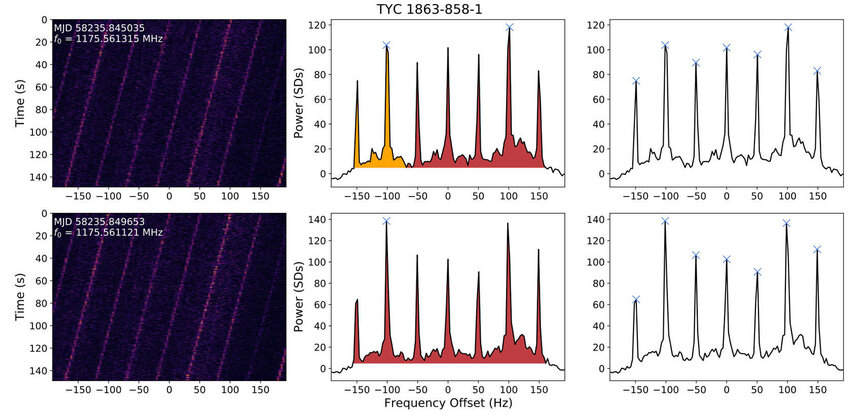Create a free profile to get unlimited access to exclusive videos, sweepstakes, and more!
Listening for techno-savvy aliens: a search of 31 nearby Sun-like stars

If technologically advanced aliens wanted to talk to us, how would they do it?
The easiest way is probably using radio waves. They're easy to make (we've been doing it since the 19th century) and easy to detect (the first radio telescope was built in the 1930s). They move at the speed of light, can be encoded with lots of information — that's how radio stations work, after all — and can be detected for thousands of light years, a pretty big chunk of the Milky Way galaxy.
The hard part is knowing when they're talking to us. Many astronomical phenomena emit radio waves too, so the sky is pretty loud, making the alien signal hard to detect. One way to avoid that is to assume our stellar buddies use a narrow band radio transmission; that is, they transmit at as specific a frequency as possible. Tuning a radio telescope to look for narrow emission in that way helps detect that signal hugely (as a perfect analogy it's like tuning your radio to a station broadcasting at a specific frequency compared to all the frequencies listed on the dial).
With all this in mind, a team of astronomers used the ginormous 100-meter Green Bank Telescope in West Virginia to look at 31 Sun-like stars to check them for narrow-band radio signals. Why those stars? As they write, "…because their properties are similar to the only star currently known to harbor a planet with life." Hmmm, a little snark in a scientific paper is appreciated.
The idea wasn't so much to actually look for aliens, though that would be a pretty sweet bonus, but more to test out a new algorithm they designed to tease signals out of the noise. They looked at each star for five minutes, in April 2018 and again in April 2019.
The results? They detected 26,631,913 candidate signals. Yes, 26 million. Their new algorithm (which I'll get to in a sec) screened out 26,588,893 of them (99.84%) as anthropogenic — that is, coming from humans. Radio transmissions, satellites, radar, and all sorts of human tech can emit radio waves, and they were able to find those pretty well and eliminate them.
Of those left, 90% or so were close enough to known radio frequency interference that they could be weeded out as well.
That left 4,539 candidate signals. They checked all those by hand, amazingly enough, and found…
... they too were all from radio interference. So, out of 26 million sources, not a single one was from aliens. Bummer*.
What's nifty though is what they did. Finding a sharp, narrow radio signal isn't that hard. But if there are a lot close together in frequency some search algorithms can get confused, and only find the brightest one in the pack.
What they did instead was search using what is called topographical prominence. This is a concept used when mapping mountains, and it quantifies how tall a mountain is relative to the terrain around it. You can get a tall mountain, for example, that's easy to spot if it's relatively isolated (like Kilimanjaro, for example) but more difficult to ID if there are lots of slightly smaller mountains all around it.
By measuring the prominence of narrow radio signals they were able to find signals that were still interesting but unlikely to be found using standard search methods. They wound up finding something like 200 times as many candidate signals as other methods this way.
That's impressive. They also wanted to know how many signals they might be missing anyway, so they ran a test where they added fake signals to their data and ran their search routine to see if it could find them. It did well, finding 93% overall, which went up to 98% if there weren't a lot of interference signals near them in the data. On top of that, of the signals it found it was able to autonomously ID 99.7% of those as technological in origin.
It sounds to me that if the Kree or the Vulcans or the Goa'uld are out there and chatting via radio, this process would find them. I'll note that we might find such a signal sent by accident; our own radar signals can be detected over interstellar distances by sensitive telescopes (heck, the late Arecibo telescope could be used as a radar dish to help map out nearby asteroids; that beam is powerful and could be seen by nearby aliens).
I don't know if we'll ever find aliens, let alone how. Unless faster-than-light travel is possible (and I'd bet against it right now) it's really hard to go from star to star. Not impossible, just hard, and it's far easier to just send radio signals instead. So this does seem like a decent bet.
Our tech gets better all the time, allowing us to search the galaxy more efficiently all the time as well. Perhaps soon we'll have an answer. If we are alone, or we find we are not… well. Either result is profound.
*I mean, c'mon. What were you expecting when you started reading this article? If astronomers found convincing evidence of technological aliens trying to say hi I would've used a far different headline, and probably would've led with that fact.





























